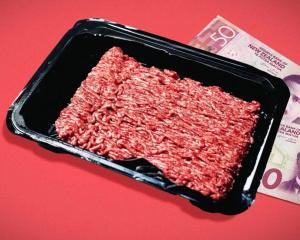
Taieri dairy farmer Hamish Jenkins has surplus calves arriving but no-one wanting to rear them for beef despite a buoyant meat market.
"I have no buyers for them."
Mr Jenkins 50:50 sharemilks his cows on the farm which surrounds, and is owned by, Dunedin Airport.
More of his surplus calves were put on the "bobby truck" to the meatworks, four days after being born, rather than being sold to rearers to grow for beef.
The same calf fetched up to $30 as a bobby and about $100, or more, to a rearer.
Calf prices were set by the industry, rather than farmers, he said.
"I don’t know who sets the price."
Some of his surplus calves were sired by a Hereford bull and should be grown for a couple of years and slaughtered for beef, but no-one was calling him, or his stock agent, to buy them.
He was keen to find a way for fewer calves to be put on a bobby truck each season.
In a perfect world, before calving each season, he would sign a contract with a rearer for the sale of all his surplus calves, at a bulk discounted price, which would require them to be collected daily when each animal was four days old, even if it was a single animal each day.
"It never seems to be as simple as that."

" I don’t want to give it one more feed than I need to. We’re feeding hundreds of calves at that time, and everyone’s busy as."
A rearer collecting calves later than expected never offered to pay a farmer more to cover the cost of the extra milk a farmer supplied.
In comparison, a bobby truck arrives every day, as planned, even for a single calf.
If a calf was born and no rearer wanted it, it was put on the bobby truck.
Calf rearers never bought scores of calves.
"Nobody comes and buys 100. You’re talking hobby farmers."
Hypothetically, another contract option could be dairy farmers supplying 100 bull calves for free at 24 days old to a rearer and then the farmer gets paid a percentage when the cattle were slaughtered in two years’ time.
To get more cattle from the dairy industry grown for beef it would require a partnership between dairy and meat companies and owners of big farms.
"I think it is doable but it needs a few people to get together."
Any deal needed to be transparent and structured, so that it was fair to every party involved, no matter the variability in a season.
"I’d love it to work but you don’t want anyone to miss out."
Maybe a system similar to owning a share in a racehorse could work.

The beef market was not a consideration when he made mating decisions for his herd.
"That’s not my market, I’m designed to make milk."
A calf from a dairy cow, sired by a Hereford bull, was easy to identify because it had a white face.
If a calf had a clean white face, it was more appealing to a rearer, which made no sense.
"The ugly-faced ones don’t go despite being bigger."
The bottom quarter of his herd were inseminated with Hereford bull semen with a short gestation length.
A cow with a shorter gestation length had more days producing milk.
"I’m trying to keep a simple system."
Any surplus calves he sold made about $5000 for his business each season, less than what he earned from a day’s milk production.
Calves required a lot of work.
"You have to teach every one of them how to drink: it is a big job."













